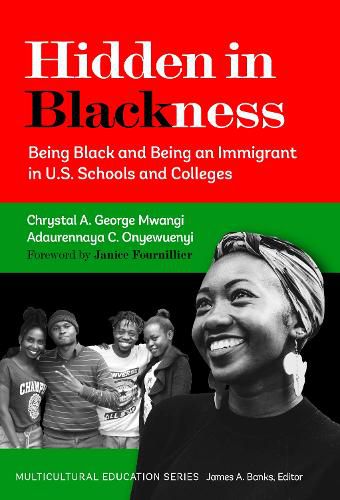Readings Newsletter
Become a Readings Member to make your shopping experience even easier.
Sign in or sign up for free!
You’re not far away from qualifying for FREE standard shipping within Australia
You’ve qualified for FREE standard shipping within Australia
The cart is loading…






Hidden in Blackness analyzes the experiences, perspectives, and development of Black immigrant students, while also complicating how race, ethnicity, nativity, and nationality are understood across the P-20 education landscape. The authors unpack how Blackness and anti-Black racism in the United States can foster Black immigrants becoming hidden in Blackness in schools and education research-meaning their Black identity is homogenized into a U.S. construction of Blackness while their ethnicity, nationality, and nativity go unacknowledged or is weaponized to subjugate other people of Color. The book culminates by offering the Black Diasporic Illumination (BDI) framework with recommendations for supporting these students with a positive sense of self and abilities in the face of racial realities. BDI bridges sociocultural ecology, ethnic-racial identity and socialization scholarship, asset orientations, and critical constructions of race and racism into a transdisciplinary approach for understanding the experiences of Black immigrants in U.S. education.
Book Features:
Spans the experiences and outcomes of both K-12 and higher education Black immigrant students to provide a more complete picture. Integrates a structural lens that considers the role of systemic racism, nativism, xenophobia, anti-Blackness, and white supremacy embedded within the educational experience. Amplifies the rich diversity that exists among Black communities and immigrant communities in the United States. Offers researchers, practitioners, and policymakers guidance for better supporting these students through awareness of their educational experiences, needs, challenges, and successes. Provides insights into the demographic diversity of Black immigrants (e.g., parental education level, nationality, ethnicity, English-language proficiency, and citizenship/ documentation status) and how these shape educational experiences and outcomes differently.
$9.00 standard shipping within Australia
FREE standard shipping within Australia for orders over $100.00
Express & International shipping calculated at checkout
Hidden in Blackness analyzes the experiences, perspectives, and development of Black immigrant students, while also complicating how race, ethnicity, nativity, and nationality are understood across the P-20 education landscape. The authors unpack how Blackness and anti-Black racism in the United States can foster Black immigrants becoming hidden in Blackness in schools and education research-meaning their Black identity is homogenized into a U.S. construction of Blackness while their ethnicity, nationality, and nativity go unacknowledged or is weaponized to subjugate other people of Color. The book culminates by offering the Black Diasporic Illumination (BDI) framework with recommendations for supporting these students with a positive sense of self and abilities in the face of racial realities. BDI bridges sociocultural ecology, ethnic-racial identity and socialization scholarship, asset orientations, and critical constructions of race and racism into a transdisciplinary approach for understanding the experiences of Black immigrants in U.S. education.
Book Features:
Spans the experiences and outcomes of both K-12 and higher education Black immigrant students to provide a more complete picture. Integrates a structural lens that considers the role of systemic racism, nativism, xenophobia, anti-Blackness, and white supremacy embedded within the educational experience. Amplifies the rich diversity that exists among Black communities and immigrant communities in the United States. Offers researchers, practitioners, and policymakers guidance for better supporting these students through awareness of their educational experiences, needs, challenges, and successes. Provides insights into the demographic diversity of Black immigrants (e.g., parental education level, nationality, ethnicity, English-language proficiency, and citizenship/ documentation status) and how these shape educational experiences and outcomes differently.